
Middelburg is a city and municipality in the south-western Netherlands serving as the capital of the province of Zeeland. Situated on the central peninsula of the Zeeland province, Midden-Zeeland, it has a population of about 48,000.
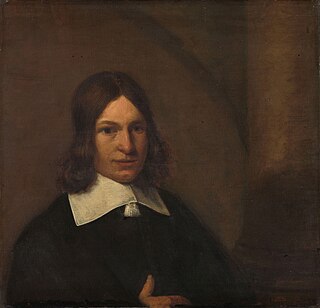
Pieter de Hooch was a Dutch Golden Age painter famous for his genre works of quiet domestic scenes with an open doorway. He was a contemporary of Jan Vermeer in the Delft Guild of St. Luke, with whom his work shares themes and style.
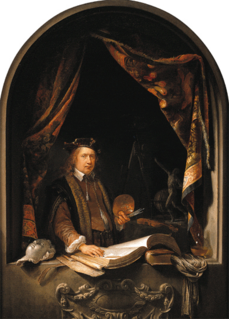
Gerrit Dou, also known as GerardDouw or Dow, was a Dutch Golden Age painter, whose small, highly polished paintings are typical of the Leiden fijnschilders. He specialised in genre scenes and is noted for his trompe-l'œil "niche" paintings and candlelit night-scenes with strong chiaroscuro. He was a student of Rembrandt.

Jan Gossaert was a French-speaking painter from the Low Countries also known as Jan Mabuse or Jennyn van Hennegouwe (Hainaut), as he called himself when he matriculated in the Guild of Saint Luke, at Antwerp, in 1503. He was one of the first painters of Dutch and Flemish Renaissance painting to visit Italy and Rome, which he did in 1508–09, and a leader of the style known as Romanism, which brought elements of Italian Renaissance painting to the north, sometimes with a rather awkward effect. He achieved fame across at least northern Europe, and painted religious subjects, including large altarpieces, but also portraits and mythological subjects, including some nudity.
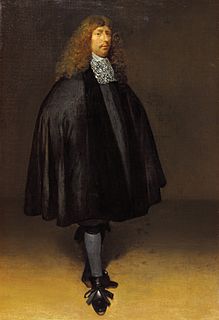
Gerard ter Borch, also known as Gerard Terburg, was a Dutch genre painter who lived in the Dutch Golden Age. He influenced fellow Dutch painters Gabriel Metsu, Gerrit Dou, Eglon van der Neer and Johannes Vermeer. According to Arthur K. Wheelock Jr., Ter Borch "established a new framework for subject matter, taking people into the sanctum of the home", showing the figures' uncertainties and expertly hinting at their inner lives. His influence as a painter, however, was later surpassed by Vermeer.
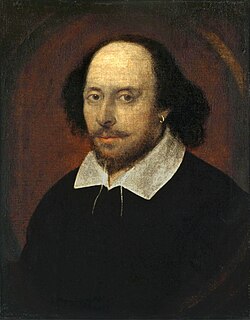
The Chandos portrait is the most famous of the portraits that are believed to depict William Shakespeare (1564–1616). Painted between 1600 and 1610, it may have served as the basis for the engraved portrait of Shakespeare used in the First Folio in 1623. It is named after the Dukes of Chandos, who formerly owned the painting. The portrait was given to the National Portrait Gallery, London on its foundation in 1856, and it is listed as the first work in its collection.

Gonzales Coques was a Flemish painter of portraits and history paintings. Because of his artistic proximity to and emulation with Anthony van Dyck he received the nickname de kleine van Dyck. Coques also worked as an art dealer.
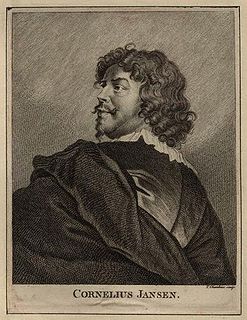
Cornelius Johnson or Cornelis Janssens van Ceulen was an English painter of portraits of Dutch or Flemish parentage. He was active in England, from at least 1618 to 1643, when he moved to Middelburg in the Netherlands to escape the English Civil War. Between 1646 and 1652 he lived in Amsterdam, before settling in Utrecht, where he died.
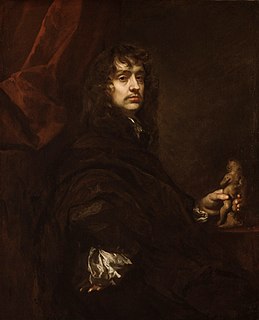
Sir Peter Lely was a painter of Dutch origin whose career was nearly all spent in England, where he became the dominant portrait painter to the court.

No contemporary physical description of Shakespeare is known to exist. The two portraits of him that are the most famous are the engraving that appears on the title-page of the First Folio, published in 1623, and the other is the sculpture that adorns his memorial in Stratford upon Avon, which dates from before 1623. Experts and critics have argued that several other paintings from the period may represent him, and more than 60 portraits purporting to be of Shakespeare were offered for sale to the National Portrait Gallery within four decades of its foundation in 1856, but in none of them has Shakespeare's identity been proven.

Adriaen Hanneman was a Dutch Golden Age painter best known for his portraits of the exiled British royal court. His style was strongly influenced by his contemporary, Anthony van Dyck.

Gerard Johnson was a sculptor working in Jacobean England who is traditionally supposed to have created Shakespeare's funerary monument. In May 1612 Johnson was paid for making part of a fountain for the east garden at Hatfield House, Hertfordshire.

Willem Wissing, known in England as William Wissing, was a Dutch portrait artist who worked in England.

Gerard Soest, also known as Gerald Soest, was a portrait painter who was active in England during the late 17th century. He is most famous for his portraits of William Shakespeare and Samuel Butler, but painted many members of the English gentry.

Dirck van Delen or Dirck Christiaensz van Delen was a Dutch painter who specialized exclusively in architectural paintings, principally depicting palace perspectives and church interiors.
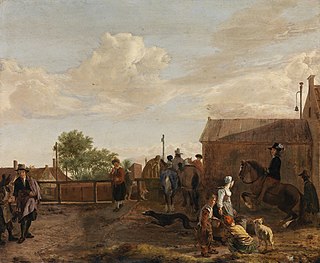
Ludolf de Jongh or Ludolf Leendertsz. de Jongh was a Dutch painter, known for his genre scenes, hunting scenes, history paintings, landscapes, cityscapes and portraits. He was further a merchant, an officer in the civil guard of Rotterdam and a schout (sheriff) of Hillegersberg. He was in the 1650s the leading genre painter in Rotterdam whose work influenced artists such as Pieter de Hooch. He was active as a staffage painter and added the figures in the works of artists such as the church interior painter Anthonie de Lorme and the landscape painter Joris van der Haagen.

Charles Emmanuel Biset or Karel Emmanuel Biset was a Flemish painter who had a peripatetic career working in various cities and countries including his hometown Mechelen, Paris, Annonay, Brussels, Antwerp and Breda. He worked in many genres including genre scenes of interiors with merry companies and gallery paintings, history painting, still life and portraiture.
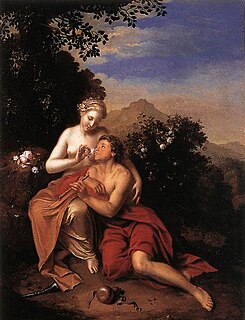
Pieter van der Werff was a Dutch Golden Age painter. He assisted his older brother, Adriaen van der Werff.

The Flagmen of Lowestoft are a collection of thirteen paintings by Sir Peter Lely, painted in the mid-1660s. They were originally part of the Royal Collections, though most were given to Greenwich Hospital in the nineteenth century, and are now in the National Maritime Museum in London. The paintings are of prominent naval officers, most of them of flag rank, who had fought at the Battle of Lowestoft in 1665. Lely at the time was Principal Painter to King Charles II.

Daniël de Blieck, was a Dutch Golden Age painter, draughtsman and architect, who specialised in architectural paintings. He painted both real and imaginary church interiors.



















